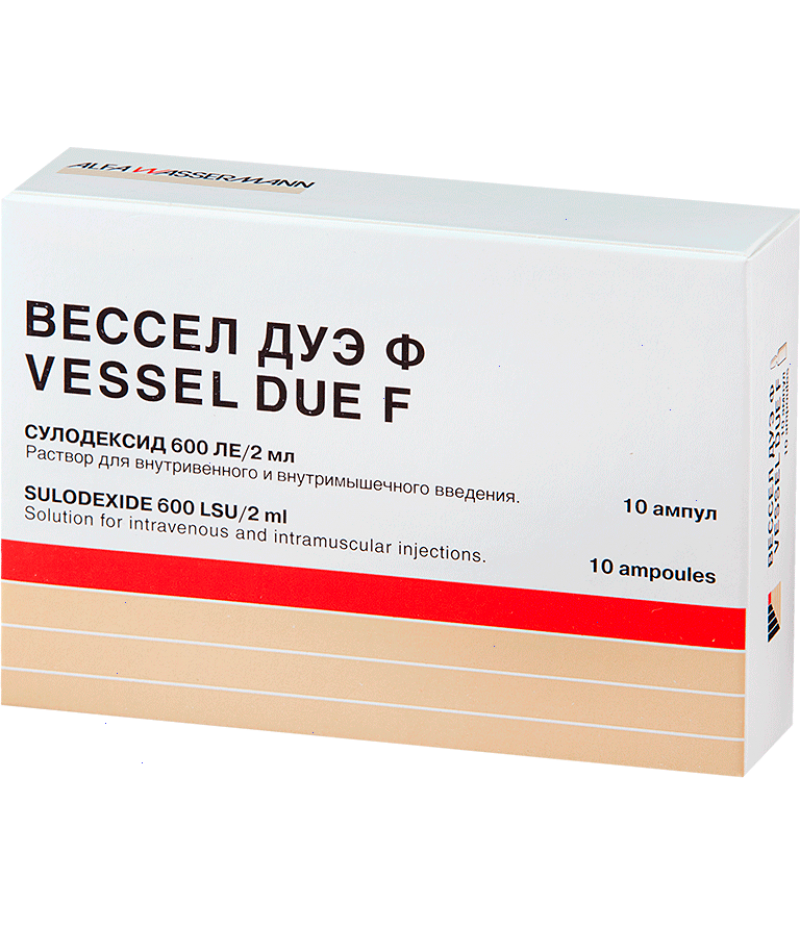Vessel Due F 250 #60
- $99.83
- 3 or more $99.40
- Availability:In Stock
Vessel Due F – Effective Anticoagulant & Vascular Support Contains sulodexide, a natural anticoagulant derived from porcine intestinal mucosa Supports blood flow by reducing clot formation and i..
Tags: caps
Vessel Due F – Effective Anticoagulant & Vascular Support
- Contains sulodexide, a natural anticoagulant derived from porcine intestinal mucosa
- Supports blood flow by reducing clot formation and improving vessel health
- Available as convenient soft capsules and injectable solution
- Commonly used for deep vein thrombosis, vascular complications of diabetes, stroke recovery
- May help reduce blood triglycerides and protect against microangiopathy
Order Vessel Due F now – reliable vascular support with worldwide shipping available.
What is Vessel Due F?
Vessel Due F is a medication containing sulodexide, a natural mixture of glycosaminoglycans (dermatan sulfate and heparin-like fraction) extracted from pig intestinal mucosa. It acts as a direct anticoagulant with additional protective effects on blood vessels.
How Does It Work?
Sulodexide helps reduce blood clotting by enhancing anticoagulant proteins and promoting fibrinolysis (breakdown of clots). It also supports the health and integrity of blood vessel walls and helps normalize blood flow. The drug has anti-inflammatory and lipid-lowering properties, reducing triglycerides and improving blood rheology.
Forms & Composition
- Soft capsules: Each contains 250 LE sulodexide in a gelatin shell.
- Injectable solution: Ampoules with 600 LE sulodexide in a clear yellowish solution.
Additional ingredients include silicon dioxide, sodium lauryl sarcosinate, triglycerides, and stabilizers in the capsule shell.
Indications
- Deep vein thrombosis and phlebopathy
- Stroke (acute and recovery phases)
- Post-myocardial infarction vascular complications
- Vascular dementia and diabetic microangiopathies (retinopathy, nephropathy, neuropathy)
- Peripheral artery disease linked to diabetes and atherosclerosis
- Antiphospholipid syndrome and heparin-induced thrombocytopenia
How to Use Vessel Due F
Initial treatment is usually done with injections (intravenous or intramuscular) for 15–20 days. Typical dose: dissolve 2 ml (600 LE) in 200 ml saline for IV drip or bolus injection.
After injection therapy, switch to oral capsules: 1 capsule twice daily, preferably between meals, for 30–40 days. Usually, two treatment courses per year are recommended.
Treatment may be adjusted based on individual needs and tolerability by your healthcare provider.
Possible Side Effects
- Skin rashes and allergic reactions
- Epigastric pain, nausea, vomiting
- Injection site pain or burning
- Hematoma formation after injections
Precautions & Contraindications
- Not recommended for patients with bleeding disorders or low blood clotting
- Avoid in first trimester of pregnancy
- Do not use if allergic to sulodexide or related components
- Requires regular monitoring of blood coagulation parameters (APTT, clotting time, antithrombin-2)
- Avoid combining with other anticoagulants or antiplatelet drugs without medical advice
Storage & Shelf Life
Store at temperatures up to 30°C, protected from light. Keep out of reach of children. Shelf life is 5 years.
Use During Pregnancy and Lactation
Not recommended during the first trimester of pregnancy. May be used under medical supervision during the second and third trimesters for vascular protection in diabetic patients. Safety during breastfeeding is not established.
User Reviews
Doctors report good effectiveness of Vessel Due F in treating thrombosis and diabetic vascular complications. When used as prescribed, the drug is generally well tolerated, including during pregnancy under supervision.
Buy Vessel Due F today for trusted anticoagulant and vascular support — order now with worldwide shipping.



